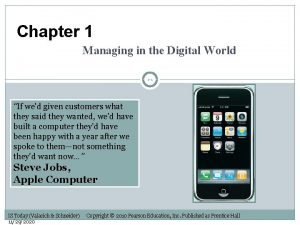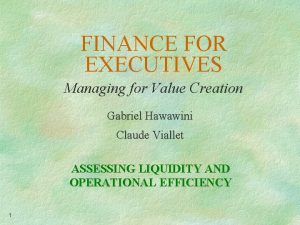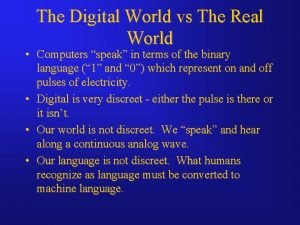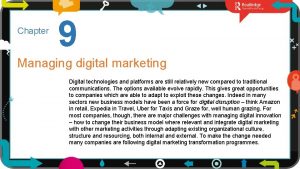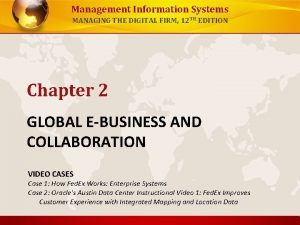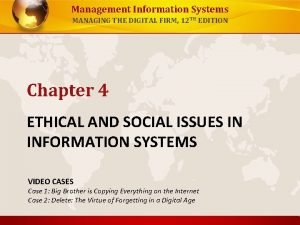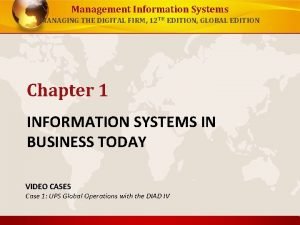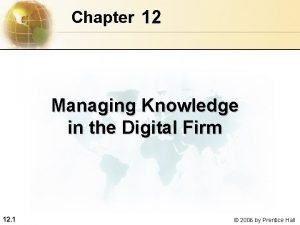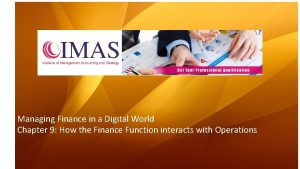Managing Finance in a Digital World Chapter 8














- Slides: 14

Managing Finance in a Digital World Chapter 8: Data to create & preserve value for Organisations

Data to Create & Preserve Value for Organisations Learning Outcome C 2. Explain the competences required to use data to create & preserve value for organisations Component C 2) Explain the competences that finance professionals need in: a) Data strategy & planning b) Data engineering, extraction & mining c) Data modelling, manipulation & analysis d) Data & insight communication § § § Assessment of data needs. Extraction, transformation & loading (ETL) systems. Business (BI) systems. Big Data analytics. Data Visualisation. 2

Data Strategy & Planning Data requirements and stakeholders Stakeholder- is anybody who can affect or be affected by an organisations actions. Table below summarises some of the main stakeholders of the finance function as well as considering the data needs of each group.

Data Strategy & Planning

Data Engineering, Extraction & Mining Extraction, transformation and loading (ETL) are three stages in transferring data. They are combined into a single tool to automatically bring data from various sources into a destination system.

Data Engineering, Extraction & Mining 1. Extraction – data harvested from a variety of sources. Data profiling is an important part of the extraction phase. Data profiling – analyses to understand the content, format and structure. This is used in the coding for the extraction and transformation stages. 2. Transformation – the source data into the required format for its intended use. 3. Loading – the newly cleaned and sorted data to the destination database or data warehouse. Data warehouse – sees data held in a systematic format ready for further use by the business intelligence (BI) function.

Data Engineering, Extraction & Mining Business intelligence (BI) Business intelligence is the technology driven process of analysing business data to generate insightful and actionable information with a view to improving the operations or products of a business. ETL is a component of a wider business intelligence or BI process. ETL provides the required data, BI accesses and analyses this data further for information and insight. Data visualisation is then used by BI to present findings to the wider business. The new technologies of the digital world are driving development in ETL systems to meet the needs of BI, the main features and challenges include: ü The rate of growth in data ü The variety in types and sources of data ü New technology such as Hadoop and Google. Big. Query are designed for the world of big data.

Data Modeling, Manipulation & Analysis Data modelling and the finance function A data model considers the data of an organisation in a systematic way that allows it to be stored and retrieved in an efficient and effective manner. Some of the advantages of a deliberate and consistent approach to data through the use of organisation wide data modelling include: ü Foundation for handling data, it facilitates the effective use of data throughout the organisation. ü Enforces business rules and helps achieve regulatory compliance by ensuring data is complete and secure. ü Consistency of naming conventions and values ultimately underpin a systematic and reliable database. ü The quality of data is enhanced as data modelling provides an organisation with a well-planned approach, Ensuring completeness and facilitating high quality data warehouses.

Data Modeling, Manipulation & Analysis Data manipulation is the process of changing data to make it easier to read. It involves adding, deleting, querying and modifying data in a data-store using a data manipulation language or DML. A data model outlines the parameters of data held in a database. A data manipulation language or DML is then used to search and interrogate the data. This DML is essentially the basis for instructions used to search and question a database. For instance from the finance perspective a DML gives the ability to interrogate the data base to compile reports and analysis to support decision making. A data model considers the data of an organisation in a systematic way that allows it to be stored and retrieved in an efficient and effective manner.

Data Insight & Communication Managing big data – the finance function Big data is a huge opportunity for businesses. In order to realise the potential big data offers a business needs a coherent data strategy. Data strategy is a coherent approach for organising, governing, analysing and deploying an organisations information assets. Digital technology and the use of data in modern businesses must be considered at a strategic level and be a central component of an overall business strategy. A key element of any data strategy will look at how to cope with the attributes of big data as outlined by the 4 V’s:

Data Insight & Communication

Data Insight & Communication Data visualisations and the finance function Data visualisation focuses on providing information to users in a practical and straightforward way. In order to produce an effective data visualisation the following three questions should be considered: § Who are the audience? Including things like what is their background? Are they technically minded etc. ? § How do they want the data? The focus should be to provide data to meet the end users requirements. § What outcome do we want? What is the intended purpose of the data and how can this be achieved in the most straightforward manner. Business focused data Data scientists are individuals with the ability to extract meaning from and interpret data, which requires both tools and methods from statistics and machine learning.

Data Insight & Communication Organisations looking to capitalise on data are employing specialist data scientists. This is a hybrid field comprising a mix of maths, statistics, programming and computer science. Therefore it is more academic than commercial in nature. Management accountants are increasingly acting as an interface between the business and the data specialists, acting to translate data into commercial information; management accountants are uniquely positioned to do so for the following reasons: ü All activities have a financial consequence so the finance function is central to an organisation with a unique understanding of the overall business picture. ü Information produced is trusted, typically audited and grounded in factual accounting reality. ü The management accounting function and the information produced provides the basis of performance management across the business already. ü Finance professionals have credibility and ethical guidelines which underpin their objectivity and rigour in decision making.

Test Your Knowledge ?
 Managing finance in a digital world
Managing finance in a digital world Managing in a digital world
Managing in a digital world Managing in a digital world
Managing in a digital world Diamond shape finance function
Diamond shape finance function Finance for executives: managing for value creation
Finance for executives: managing for value creation Real world vs digital world
Real world vs digital world Managing digital marketing
Managing digital marketing Managing digital communications
Managing digital communications Management information system managing the digital firm
Management information system managing the digital firm Management information systems managing the digital firm
Management information systems managing the digital firm Managing the digital firm
Managing the digital firm Managing knowledge in the digital firm
Managing knowledge in the digital firm Sffcu auto loan rates
Sffcu auto loan rates Digital trade
Digital trade Ap world history chapter 25 africa and the atlantic world
Ap world history chapter 25 africa and the atlantic world


